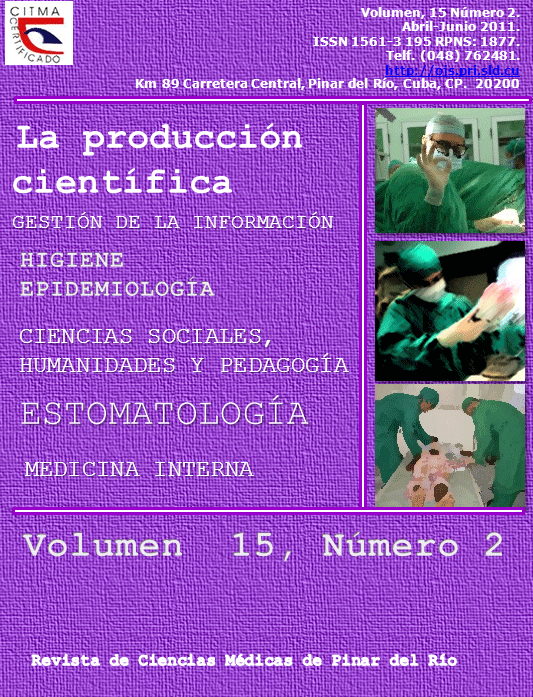Hipomelanosis de Ito. Presentación de un caso / Hypomelanosis of Ito. A case report
Abstract
La hipomelanosis de ito, es un síndrome neurocutáneo con un grado de despigmentación dérmica variable y alteraciones del neurodesarrollo. Se realiza el examen físico-genético a un niño de dos años de edad, observando manchas hipocrómicas, así como otras dismorfias en la cara y el cráneo que se asocian con esta enfermedad, cuyo riesgo de recurrencia es bajo. Después de revisada la literatura médica se confirmó el diagnóstico de la afección para ofrecer adecuado asesoramiento genético a familias con personas afectadas.
DeCS: HIPOMELANOSIS DE ITO/síndrome, NEUROCUTÁNEO/máculas, HIPOCRÓMICAS/enfermedades genéticas de la piel.
ABSTRACT
Hypomelanosis of Ito is a Neurocutaneous Syndrome with a variable degree of dermal depigmentation and neurological disorders. A physical-genetic examination was performed to a two-year old boy presenting hypochromic stains, dysmorphias in face and skull associated with this condition which recurrence risk is low. After revising the medical literature the diagnosis was confirmed to offer the necessary genetic advice to families with patients suffering from this syndrome.
DeCS: Hypomelanosis of Ito/syndrome, Neurocutaneous/hypochromic, maculae/genetic skin disease.
Downloads
References
1. Pérez A, Laguna R, Jiménez J. La piel como expresión de alteraciones neurológicas en el recién nacido. An Pediatr. [Revista en Internet] 2005. [Consultado 20 de junio 2009]; 62(6): [Aprox. 15p.]. Disponible en: http://www.elsevier.es/revistas/ctl_servlet?_f=7064&ip=201.220.215.14&articuloid=13075548&revistaid=37
2. Díaz AR, Ortega KV, Olivo A, Soto ML. Análisis neuropsicológico de la hipomelanosis de Ito. Estudio de caso. Rev. Mex Neuroci. [Revista en Internet] 2007. [Consultado 20 de junio 2009]; 8(1): [Aprox. 4p.]. Disponible en: http://www.imbiomed.com.mx/1/1/articulos.php?method=showDetail&id_articulo=41629&id_seccion=1131&id_ejemplar=4260&id_revista=91.
3. Virendra N, Sehgal MD, Govind MD. Hereditary hypo/de-pigmented dermatoses: An overview. International Journal of Dermatology. [Revista en Internet] 2008. [Consultado 10 de abril 2010]; 47(10): [Aprox. 9p.]. Disponible en: http://onlinelibrary.wiley.com/doi/10.1111/j.1365-4632.2008.03105.x/pdf
4. Torrelo A. Avances en Dermatología Pediátrica. Hipopigmentaciones cutáneas. [Monografía en internet]. Novartis; 2006. [Consultado 10 noviembre del 2008]. Disponible en: http://www.sepeap.org/archivos/libros/avancesdermatologia/unidad11.pdf
5. Gupta S, Shah S, Mcgaw A, Mercado T, Zaslav A, Tegay D, et al. Trisomy 2 mosaicism in hypomelanosis of Ito. American Journal of Medical Genetics Part A. [Revista en Internet] 2007. [Consultado 10 de abril de 2010]; 143(20): [Aprox. 2p.]. Disponible en: http://onlinelibrary.wiley.com/doi/10.1002/ajmg.a.31940/full
6. Pinheiro MD, Thomas MD, Jacob M, Srivastava MD. The Clinical Profile of Children in India with Pigmentary Anomalies along the Lines of Blaschko and Central Nervous System Manifestations. Pediatric Dermatology. [Revista en Internet] 2007. [Consultado 10 de abril 2010]; 24(1): [Aprox. 6p.]. Disponible en: http://cat.inist.fr/?aModele=afficheN&cpsidt=18506624.
7. Sánchez MB, León ME. Hipertricosis localizada y mosaicismo pigmentario tipo Ito (hipomelanosis de Ito) Anales de Pediatría. [Revista en Internet] 2008. [Consultado 10 de abrill 2010]; 68(3): [Aprox. 2p.]. Disponible en: http://cat.inist.fr/?aModele=afficheN&cpsidt=20355699
8. Llamos PA, Llamos PA, Casamajor CM. Hipomelanosis de Ito. MEDISAN; [Revista en Internet] 2002 [Consultado 10 de abril 2010]; 6(4): 82-85. Disponible en: http://bvs.sld.cu/revistas/san/vol6_4_02/san13402.htm
Published
How to Cite
Issue
Section
License
Authors who have publications with this journal agree to the following terms: Authors will retain their copyrights and grant the journal the right of first publication of their work, which will be publication of their work, which will be simultaneously subject to the Creative Commons Attribution License (CC-BY-NC 4.0) that allows third parties to share the work as long as its author and first publication in this journal are indicated.
Authors may adopt other non-exclusive license agreements for distribution of the published version of the work (e.g.: deposit it in an institutional telematic archive or publish it in a volume). Likewise, and according to the recommendations of the Medical Sciences Editorial (ECIMED), authors must declare in each article their contribution according to the CRediT taxonomy (contributor roles). This taxonomy includes 14 roles, which can be used to represent the tasks typically performed by contributors in scientific academic production. It should be consulted in monograph) whenever initial publication in this journal is indicated. Authors are allowed and encouraged to disseminate their work through the Internet (e.g., in institutional telematic archives or on their web page) before and during the submission process, which may produce interesting exchanges and increase citations of the published work. (See The effect of open access). https://casrai.org/credit/



